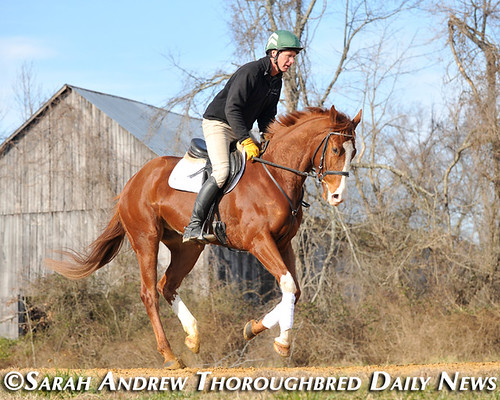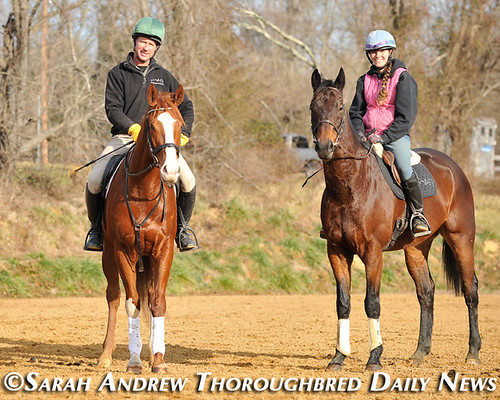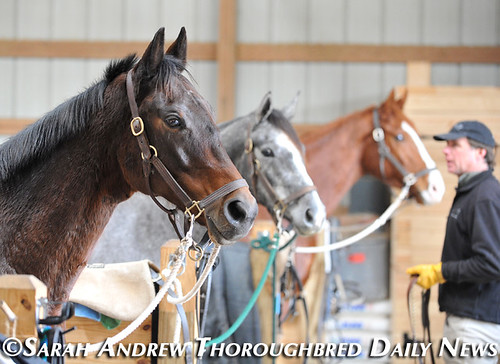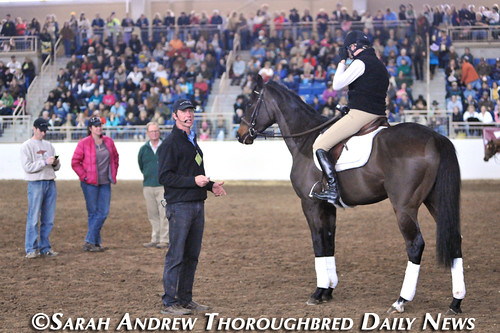 |
| Pittman and Alluring Punch |
The mission of the RRTP is to increase demand for retired
Thoroughbred racehorses as pleasure and sporthorses through public events,
clinics, training publications, videos and internet tools. On December 1, 2012,
four horses (including one former Eclipse Champion) representing four
Mid-Atlantic Thoroughbred farms embarked on the Retired Racehorse Training
Project’s (RRTP) 100 Day Thoroughbred Challenge at Dodon Farm Training Center
in Davidsonville, MD. At the end of their 100-day training period, the horses
will be judged by guest riders, judges, and online fans. Please enjoy part 2 of
my series about the 100 Day Thoroughbred Challenge, an interview with Steuart Pittman.
 |
| Pittman (left) aboard Alluring Punch and assistant trainer Michelle Warro (right) aboard Suave Jazz |
TDN: You had a very busy 2012. What are some of the
things that RRTP has done since last year's Trainer Challenge?
Pittman: We had a Thoroughbreds For All Kentucky event in
collaboration with New Vocations Racehorse Adoption Program during the Rolex
CCI**** in April. Bruce Davidson and Chris McCarron were the top attractions.
We also held the Thoroughbreds For All event at Fair Hill, combining a
marketplace of horses with education in collaboration with trainers, vets,
exercise riders at Fair Hill Training Center and New Bolton Center. We received
our first grants from Thoroughbred Charities of America and Maryland Horse
Breeders Foundation. Our website had 310,000 page views, our YouTube Channel
had 125,000 views, and we have close to 6,000 Facebook fans. Online databases of Trainers, Sources for Horses, Horse Listings, and Bloodline Brag are growing
every month. We’ve been covered some 50 times in racing and equestrian
media, as well as TV and print mainstream media.
TDN: What are your goals for the RRTP 100-Day Challenge?
Pittman: To demonstrate to the public that the Thoroughbred
racing industry continues to create outstanding riding horses, and to give equestrians
a realistic picture of what it looks like to train and ride Thoroughbreds off
the track. We want to continue increasing demand for these horses but also give
people the tools that they need to succeed with them.
TDN: How is it different from the 2012 RRTP Trainer
Challenge?
Pittman: The Trainer Challenge focused on the methods used
by the trainers. The 100 Day Challenge puts the spotlight on the
characteristics and trainability of the horses. It was important for us to have
each horse represent a major MD or PA Thoroughbred farm. We want the public to
associate these great horses with the farms that produced them. Each of these
horses has an amazing background that tells a story about an industry that is
incredibly valuable to our states.
The other difference is that all four horses are in one
location being trained by the same staff. That allows the public to see just
how unique each horse is, even when given the same opportunities. People
stereotype ex-racehorses, but the four in this Challenge remind us how each
horse is an individual.
 |
| RRTP's newest stars- from left: Suave Jazz, Gunport, Alluring Punch |
TDN: What kind of feedback have you received from the
racing world and from the sporthorse world about RRTP?
Pittman: RRTP does not tell racing people what they should
do about their retiring horses. It tells equestrians that they should get over
the obsession with warmbloods and rediscover Thoroughbreds who have raced. That
is a message that has to come from sporthorse trainers, but it has been
fantastic that the racing industry is starting to recognize the value of this
strategy. We have presented our programs as models at national conferences
hosted by NTRA, The Jockey Club, and the University of Arizona's Global Symposium on
Racing and Gaming. The Maryland racing industry has very generously supported
our work and helped launch this organization.
Within the sporthorse world, we get excellent media
coverage and have obviously attracted huge numbers of people who are passionate
about Thoroughbreds. These people have lacked an organization to rally around
and the enthusiasm has amazed me.
TDN: What can racehorse owners do to help their horses
successfully transition into a second career?
Pittman: I know enough people struggling to make it on the
backsides of Maryland tracks that I would never preach to them about what they
should do. At the same time, it is pretty obvious that if a horse can be sold
directly into a second career for at least a few thousand dollars, the pressure
to keep running them when they've lost the desire or the soundness to win is
less. Owners and trainers need better access to buyers outside of racing so
that they can be rewarded financially for retiring their horses sound.
In some cases, I believe that investing in some second
career training is a wise move for owners. A couple thousand dollars of
training often translates into a sale price of $5,000 to $10,000 more than for
a horse straight off the track. It's hard to stomach investing money in a horse
who has already broken your bank, but if the horse is sound and sane, the
payback is often there. Make sure that it's a good trainer. Try the RRTP
Trainer Directory.
The best of the nonprofit placement organizations are
excellent. You can donate the horse for a tax write-off and some of them have
access to trainers who can give the horse the help it needs. To some degree
these organizations have stepped in where "horse dealers" walked away
from Thoroughbreds. There are, however, still thousands of people who buy,
train, and sell horses off the track effectively who are independent of any
organization. Accessing them is the problem.
 |
| Pittman at the PA Horse World Expo in 2012 |
TDN: What
can we expect in 2013 from RRTP?
Pittman: We expect to bring our Thoroughbreds For All events to some
racetracks. They combine education with a marketplace of retiring horses in a
way that can benefit horsemen and create goodwill for the tracks. We also
expect to announce a new version of the Trainer Challenge that allows for a
much larger number of horses and trainers to participate. And finally, we
expect to appear at more of the major horse expos in 2013, starting with the
Delaware Horse Expo April 6 and 7.
TDN: Have you noticed any recent trends in Thoroughbred
sporthorse pedigrees/breeding?
Pittman: I used to believe that the industry was breeding
fewer big-moving, sound sporthorse types than in the past. I thought that the
decline in distances and the pressure to breed two year old winners was
shifting the product to smaller, quicker horses who would be less successful
for jumping and dressage. I have changed my mind. I keep seeing horses coming
off the tracks that I wish I could say I bred for sport. Declan's Moon proves
the point. He was the champion of his time and if I were looking for a sporthorse sire to replace my Salutely son, I would clone him.


No comments:
Post a Comment